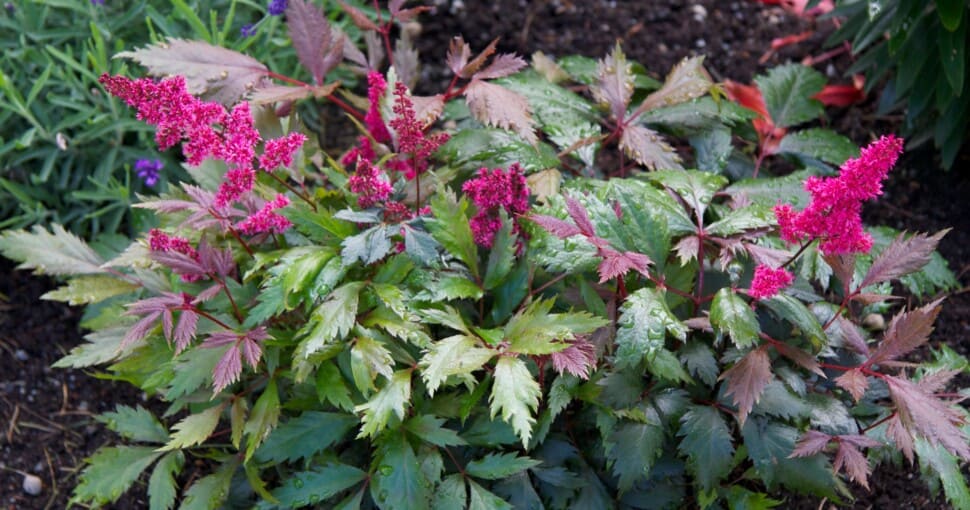Astilbe plants are popular for their large plumes of flowers that could fill your garden with color from early spring till late summer. Astilbe also called false goat’s beard, and false spirea, is native to North America and Asia, where they prefer to grow in woodlands or along mountain streams. The eighteen species of Astilbe belong to the Saxifragaceae plant family, and they are hardy perennial plants.
Contents
Astilbe plants are characterized by their fern-like compound leaves and large plumes of brightly colored flowers. There are hundreds of cultivars of Astilbe, with a wide range of colors. Varieties include form white, yellow, magenta, and pink. While there are dark-colored varieties, most Astilbe flowers are pastille colored.
The large, showy plumes comprise large clusters of tiny sterile flowers. These flowers bloom consecutively. This flowering pattern allows for a long blooming season. While the flowers are sterile, they still provide plenty of pollen, which attracts pollinators like bees to the garden.
There are wide Astilbe varieties to choose from. They all thrive in shady, moist conditions but differ largely in height and flowering season. Astilbe varieties are either early-season bloomers or late-season bloomers. Some Astilbe varieties could grow taller than two feet, while others are not even a foot tall.
This means there is a color and size to fit almost every garden, and if you plant a few varieties, you could have beautiful Astilbe flowers from early spring to late summer! Don’t fret if you live in a dry area or only have full sun in your garden. There are a few plants that look like Astilbe to choose from.
1. Goat’s Beard
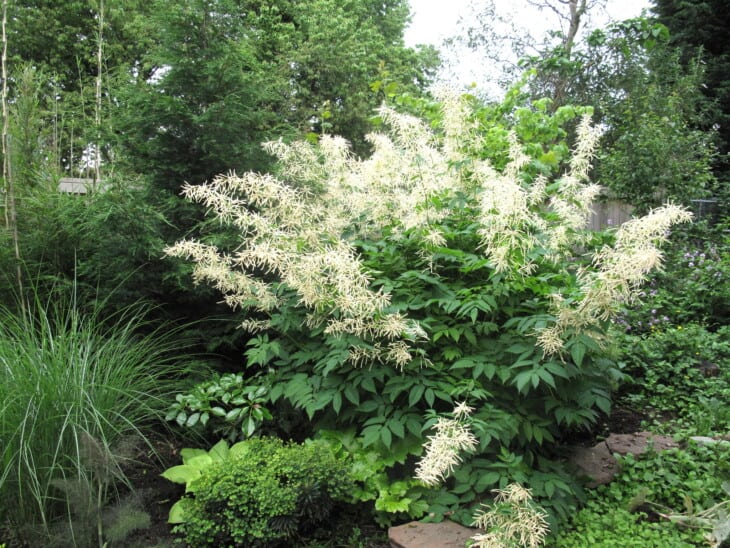
The goat’s beard plants (Aruncus dioicus) are also called bride’s feathers and buck’s-beard. Goat’s beard is a perennial plant like the Astilbe but belongs to the Rosaceae family. Like Astilbe, goat’s beard plants have compound leaves. The leaves have sharp serrations but are not as feathery in appearance as Astilbe leaves. A goat’s beard plant is either male or female. The term used to describe this is dioicus.
The male flowers are fuller and result in more attractive shrubs. Unlike Astilbe, goat’s beard flowers are only available in cream or white. This does not prevent the goat’s beard from making a big showy impact in the garden. The large flower clumps extend above the dark green foliage from early summer. A goat’s beard can grow in full sun or partial shade.
A goat’s beard plant is larger than Astilbe and can grow between four and six feet tall. The goat’s beard flowers attract bees and butterflies to the garden. A goat’s beard plant is propagated via seed in spring or fall, or established plants are divided in spring.
2. Butterfly Bush
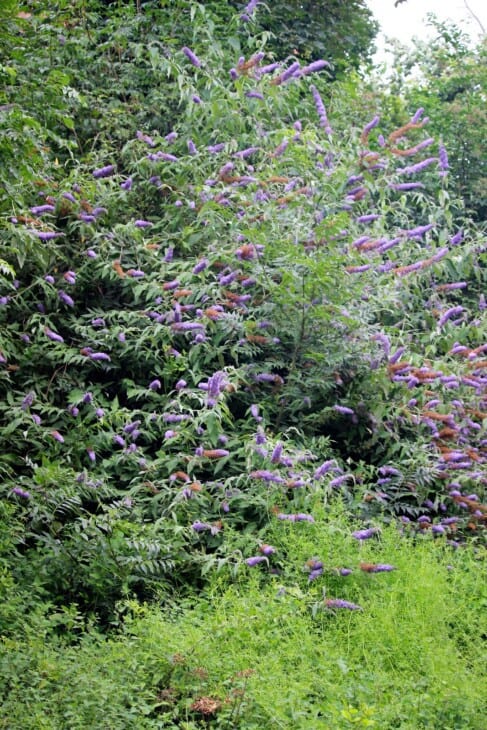
Butterfly bush (Buddleia davidii) may be more familiar by names like orange-eyed butterfly bush or summer lilac. The butterfly bush is a member of the Scrophulariaceae family and is native to North and South America, Asia, and Africa. The beautiful and fragrant blooms have ensured that this shrub has spread globally.
Like Astilbe, the butterfly bush forms large clusters of blooms comprising many small flowers. There are more than a hundred species of butterfly bush and many more hybrids. The blooms are found in white, yellow, pink, and various shades of purple. As the name indicates, these shrubs attract pollinators to your garden.
Most butterfly bush varieties grow as tall shrubs that can be sixteen feet tall. Shorter varieties that grow only one and a half feet tall are available for smaller gardens, though. Perennial varieties are available for tropical regions, while butterfly bush grows as a deciduous shrub in more temperate regions.
3. Spirea
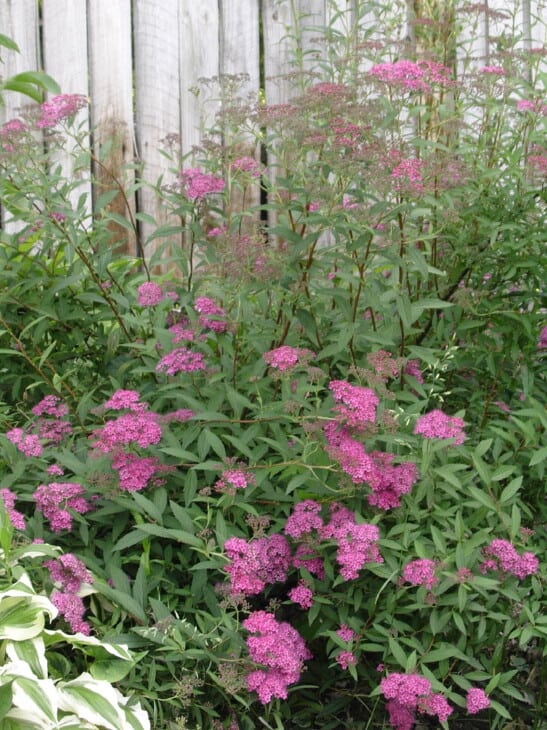
Spirea is often called steeplebush or meadowsweets and belongs to the Rosaceae plant family. Astilbe is sometimes called false spirea, likely due to both plants’ large boughs of flowers. Spirea is native to Asia and most Northern Hemisphere countries. Spirea also attracts beneficial pollinators, but not only for the flowers. Spirea is also a host plant for many moth larvae.
There are roughly a hundred species of spirea with many flower colors. Most flowers are white, shades of pink, mauve, or red, though. Like Astilbe, you can choose from varieties that bloom in spring or summer. This allows a long flower display if more than one variety is planted.
Unlike Astilbe, Spirea plants are deciduous, so they do not provide a display in winter. The Spirea shrub displays bright green leaves in spring, a long flowering season, and bright orange and red fall colors in the garden. Some Spirea shrubs are even selected for a variety of foliage colors. In addition to the dark green leaved varieties, there are also varieties with gold or chartreuse foliage.
4. Golden Giant Amaranth
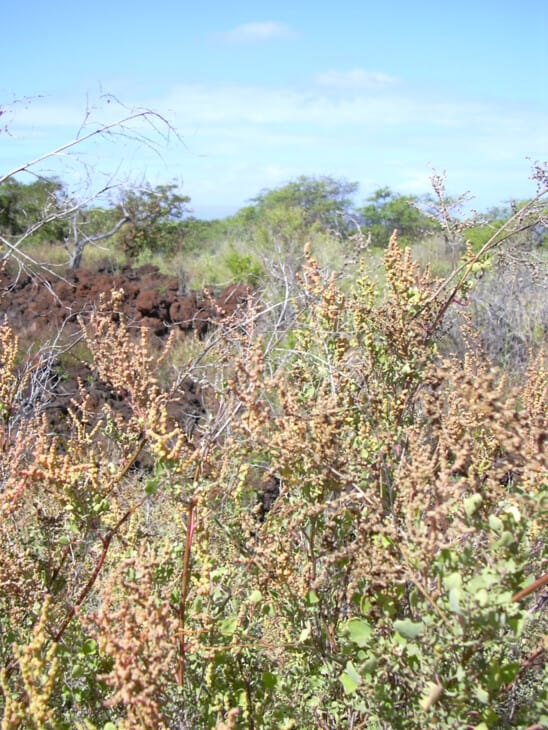
The golden giant amaranth plant (Amaranthus hybridus) is sometimes called prince’s feather, Mexican grain amaranth, and smooth amaranth. Giant amaranth belongs to the Amaranthaceae family, which includes more than two thousand plant species. This annual plant is native to North America, Central and South America, and Canada. Amaranth has become naturalized all around the globe, though.
The large flower and seed plumes of giant amaranth resemble Astilbe. The amaranth plants grow tall but do not form shrubs like Astilbe plants. Amaranth grows as a single-stem upright plant that can grow as tall as eight feet. The Golden giant amaranth has large plumes of golden yellow flowers, but you will find red, pink, purple, and even green flowers within the amaranth family.
Amaranth is not only easy to grow and very visually attractive in a garden, but it is also an excellent food source. The greens are edible as a spinach substitute, and the grains are used as a cereal. Amaranth cereal is gluten-free, high in protein, and packed with minerals. Amaranth also grows fast, so you can try new varieties each year to find your favorite. If you would like a bright leaf display, try tricolor amaranth.
5. Celosia
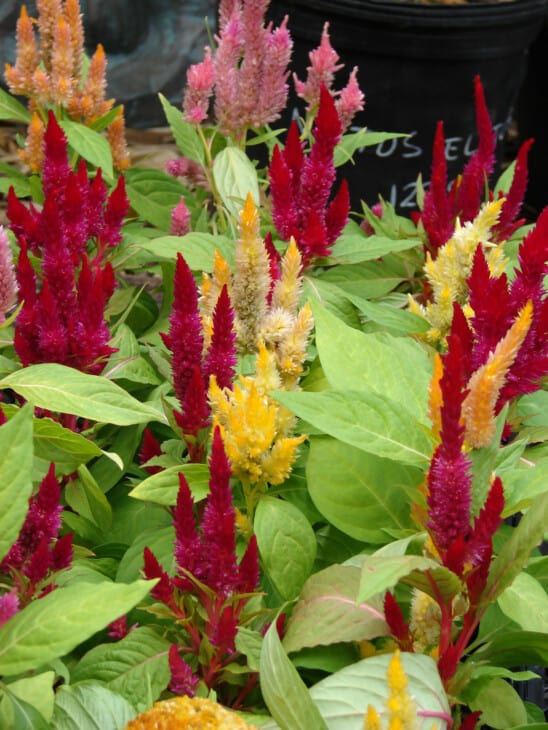
Celosia is also called woolflower, silver cock’s comb, or plumed cockscomb. Celosia is a member of the Amaranthaceae family and is both edible and ornamental. Celosia is native to Africa, India, and Nepal, where it is used mainly as a food source. Celosia is commonly grown ornamentally across the globe. The plume-shaped flowers of Celosia are similar to Astilbe flowers but take up very little space in the garden.
Celosia blooms are available in white, yellow, orange, red, pink, and purple. The flower plumes are at the top of the celosia plant, which grows between seven and twenty-seven inches tall. Some varieties of celosia blooms grow as big as ten inches. Celosia plants are easy to grow annuals, with hardly any pests, and will self-seed for a new display each year.
Celosia will also provide you with enough seed to share with friends or to use as food. Celosia is classified as a pseudo-cereal. (True cereals are grown on plants from the grass family.) As the Nigerian name attests, the leaves are well-loved as a spinach substitute. When translated, the name means to make husbands happy and fat.
5. Grape Hyacinth
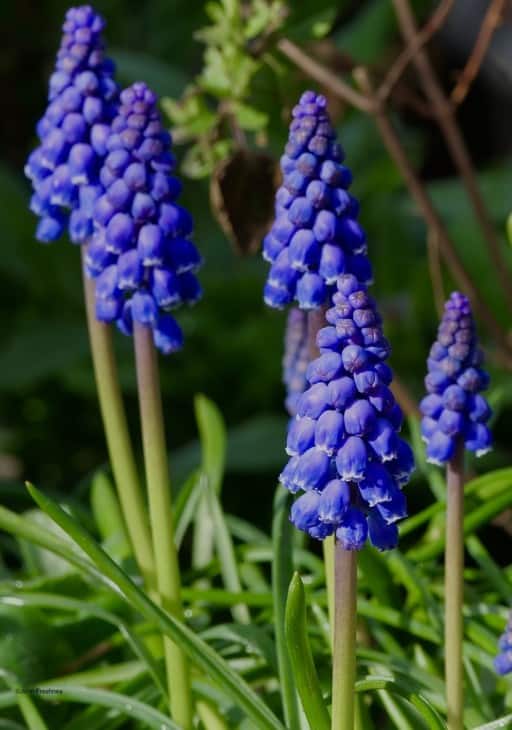
Grape hyacinths (Leopoldia comosa) are also called blue grape hyacinths, feather hyacinth and tassel hyacinths. They are members of the Asparagaceae family, and these bulbs can produce a fragrant display for many years. As with Astilbe, the grape hyacinth flowers are large plumes between six and eight inches long. These low-growing plants take up very little space but add beautiful color to a garden.
Grape hyacinths may have white or purple blooms, and they are native to the Mediterranean and commonly found along rocky outcrops. In Some Mediterranean countries, the bulbs are pickled and considered a delicacy.
Hyacinth flowers grow the same height as the lance-shaped leaves interspersed with the flower heads. They grow well in pots or as border plants. As an added benefit, deer avoid them. Grape hyacinth is named for its fruity grape-like scent and will attract beneficial pollinators to the garden. Grape hyacinths bloom for a long time, starting in early spring, and make ideal cut flowers as well.

